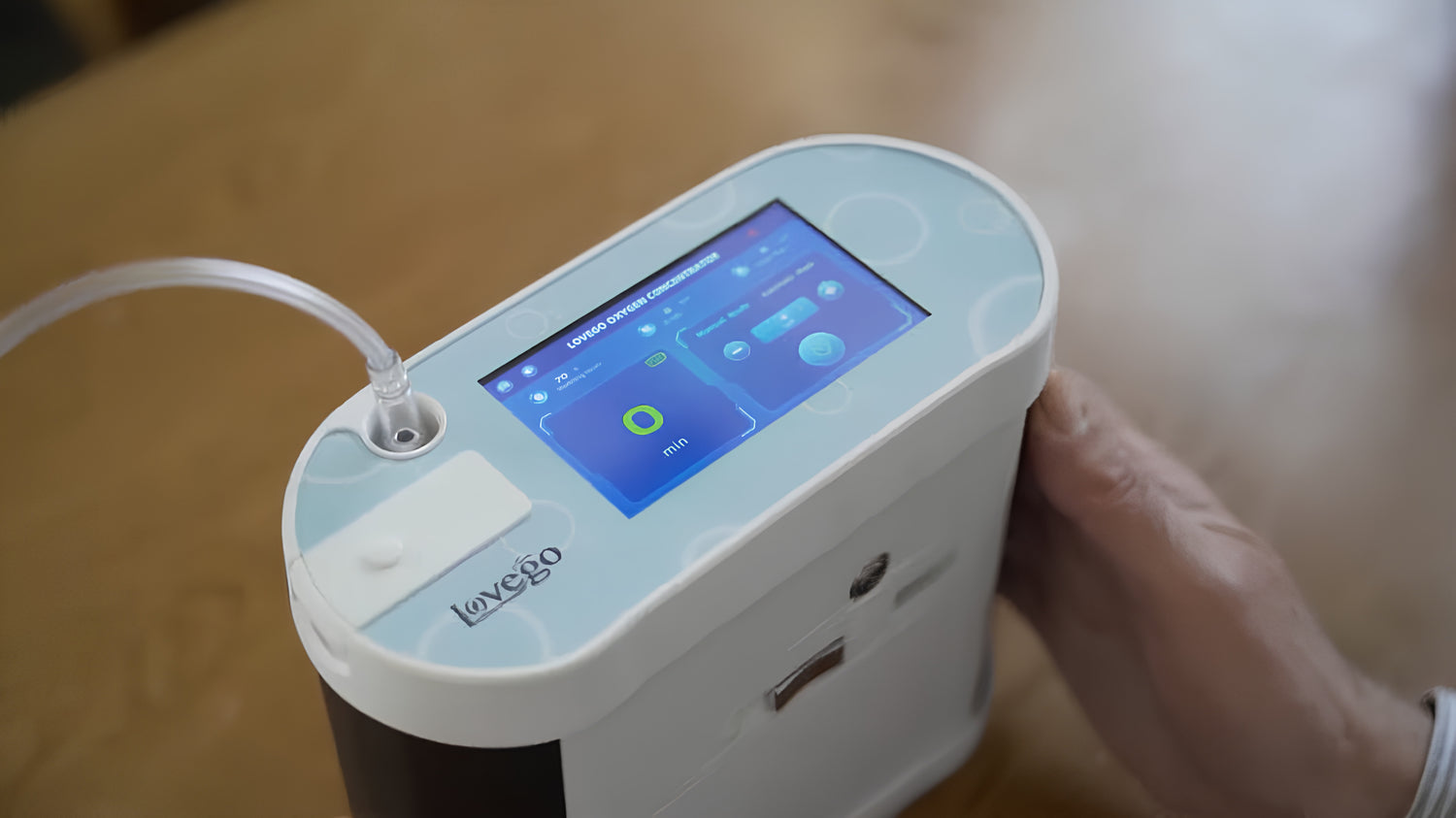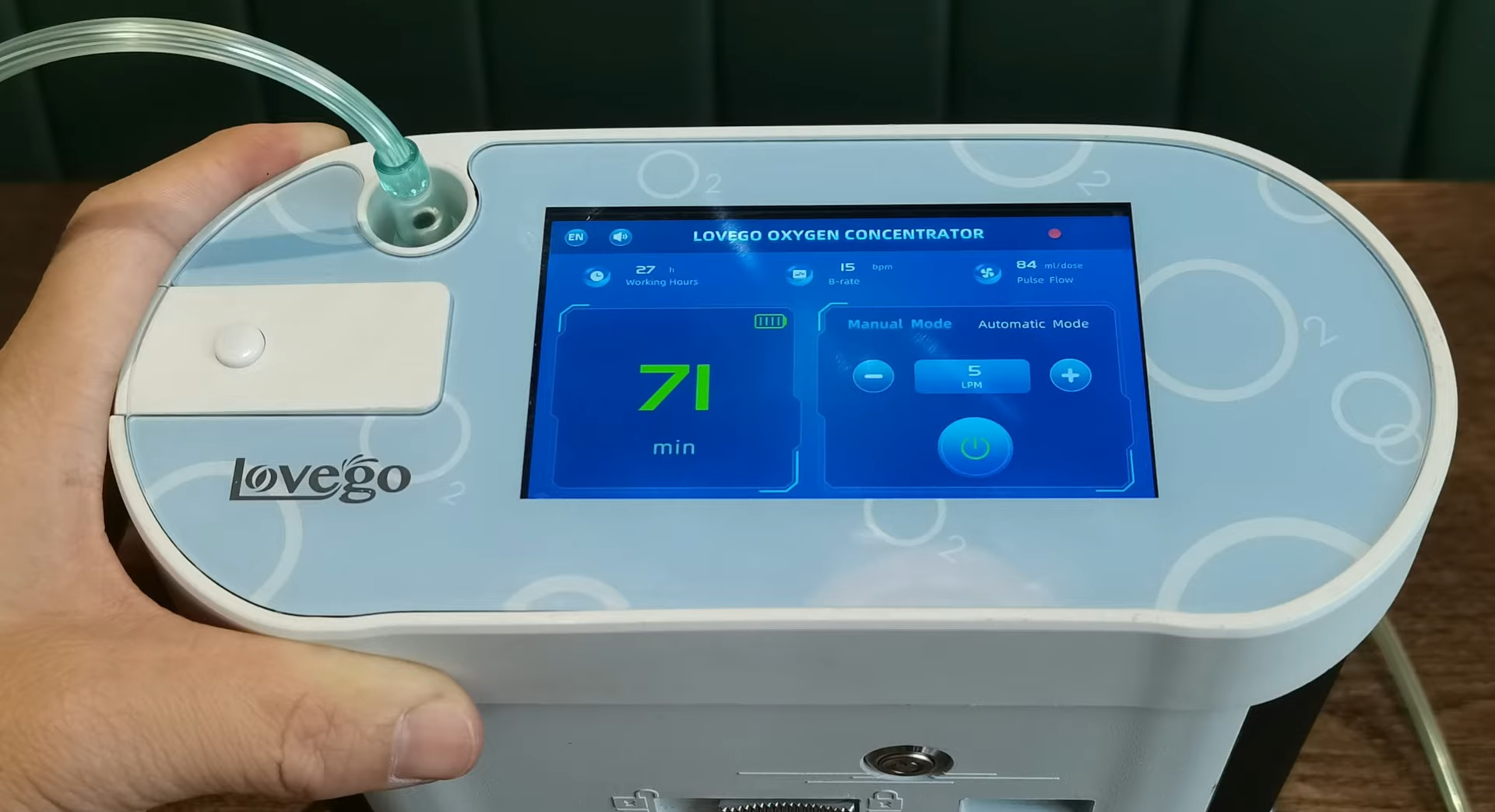Oxygen concentrators are medical devices that provide supplemental oxygen to individuals with respiratory disorders, enhancing their quality of life and overall well-being. A crucial aspect of oxygen therapy is the flow rate, which determines the amount of oxygen delivered to the patient per minute. Selecting the optimal flow rate is essential for ensuring effective treatment and patient comfort. In this article, we will explore the factors that influence the determination of the best flow rate for oxygen concentrators, taking into account individual patient needs and the various settings in which these devices are used.
What You Need to Know about Oxygen Concentrators
Oxygen concentrators are special medical devices that have made a big difference in oxygen therapy for people with breathing problems. These devices help improve patients' quality of life and overall health. In this section, we'll explore how oxygen concentrators work, the different types available, and the key parts that affect the flow rate.
How Do Oxygen Concentrators Work?
Oxygen concentrators use a process called pressure swing adsorption (PSA) to separate oxygen from other gases in the air. The device has a compressor that pulls in air and sends it through filters to remove dust, dirt, and other impurities. The cleaned air then goes into a sieve bed system, which has two columns filled with a material called zeolite that attracts nitrogen molecules.
As the air moves through the sieve beds, the zeolite traps the nitrogen, allowing the concentrated oxygen to pass through. The two sieve beds take turns in this process, with one bed trapping nitrogen while the other releases it back into the air. This back-and-forth cycle ensures a steady flow of concentrated oxygen to the patient.
Key Parts That Affect Flow Rate
Several key parts within an oxygen concentrator play an important role in determining the flow rate and overall performance of the device. These include:
- Compressor: The compressor is responsible for pulling in air from the surrounding environment and pressurizing it for the filtration and concentration process. A high-quality compressor ensures a steady and reliable flow of air into the device.
- Sieve Beds: The sieve beds, containing zeolite material, are the most important part of the oxygen concentration process. The size, quality, and efficiency of the sieve beds directly impact the device's ability to produce high-purity oxygen at the desired flow rate.
- Pressure Regulator: The pressure regulator controls the pressure of the concentrated oxygen as it leaves the device, ensuring a steady and safe flow rate to the patient. A well-adjusted pressure regulator is essential for maintaining the prescribed flow rate and preventing changes that could affect therapy effectiveness.
- Nasal Cannula or Mask: The nasal cannula or mask is the connection between the oxygen concentrator and the patient. The type and size of the cannula or mask can influence the flow rate and the patient's comfort level. Proper fitting and selection of the cannula or mask are crucial for the best oxygen delivery.
The Concept of Flow Rate in Oxygen Therapy
Flow rate is a crucial aspect of oxygen therapy that determines the amount of oxygen a patient receives per minute. It's essential to understand what flow rate means, how it's measured, and how it affects oxygen delivery to the body. In this section, we'll break down the concept of flow rate and its significance in oxygen therapy.
What is Flow Rate?
Flow rate refers to the volume of oxygen flowing from the oxygen concentrator to the patient per unit of time. In simple terms, it's the amount of oxygen the patient is receiving each minute. The flow rate is adjustable, allowing healthcare providers to customize the oxygen delivery based on the patient's specific needs and medical condition.
Measuring Flow Rate: Liters per Minute (LPM)
Flow rate is typically measured in liters per minute (LPM). This unit of measurement tells us how many liters of oxygen are being delivered to the patient each minute. For example, if an oxygen concentrator is set to a flow rate of 2 LPM, it means that the patient is receiving 2 liters of concentrated oxygen every minute.
Most oxygen concentrators have flow rate settings that range from 1 to 5 LPM, with some models offering higher settings for patients with more severe respiratory conditions. It's important to note that the flow rate should only be adjusted under the guidance of a healthcare professional to ensure safe and effective oxygen therapy.
How Flow Rate Affects Oxygen Delivery
The flow rate directly impacts the amount of oxygen that reaches the patient's lungs and bloodstream. A higher flow rate means more oxygen is being delivered, while a lower flow rate results in less oxygen delivery. The right flow rate ensures that the patient receives enough oxygen to maintain proper blood oxygen levels and support their body's functions.
When the flow rate is too low, the patient may not receive enough oxygen to meet their needs, leading to symptoms like shortness of breath, fatigue, and headaches. On the other hand, an excessively high flow rate can cause discomfort, nasal dryness, and potentially lead to oxygen toxicity in rare cases.
Finding the optimal flow rate is a delicate balance that takes into account the patient's unique respiratory needs, medical history, and lifestyle factors. Healthcare providers use various diagnostic tests and monitoring tools to determine the appropriate flow rate for each patient, which we'll explore further in the next section.
How to Determine the Right Flow Rate
Choosing the appropriate flow rate is crucial for ensuring effective oxygen therapy and promoting the patient's well-being. This section will explore the factors that healthcare providers consider when determining the right flow rate, including patient assessment, prescription requirements, and the role of diagnostic tests.
Patient Assessment and Prescription Requirements
Medical conditions that require oxygen therapy
Various medical conditions can lead to low blood oxygen levels, necessitating oxygen therapy. Some common conditions include:
- Chronic Obstructive Pulmonary Disease (COPD)
- Asthma
- Interstitial Lung Disease (ILD)
- Sleep apnea
- Pneumonia
- Heart failure
Healthcare providers assess the patient's specific condition, severity, and individual needs to determine the most appropriate flow rate.
Role of Healthcare Providers in Assessing Needs
Healthcare providers play a crucial role in assessing the patient's oxygen requirements and prescribing the right flow rate. They consider factors such as:
- The patient's medical history and current condition
- Blood oxygen levels and oxygen saturation
- Breathing rate and pattern
- Activity level and lifestyle
- Age and overall health status
Based on this comprehensive assessment, healthcare providers develop an individualized oxygen therapy plan, including the recommended flow rate.
The Importance of Pulse Oximetry and Other Diagnostic Tests
Pulse oximetry is a non-invasive test that measures the oxygen saturation level in the patient's blood. This simple, painless test involves placing a small clip-like device called a pulse oximeter on the patient's finger, toe, or earlobe. The device uses light to measure the amount of oxygen carried by the blood, providing a quick and reliable reading. Healthcare providers use pulse oximetry to:
- Assess the patient's initial oxygen needs
- Monitor the effectiveness of oxygen therapy
- Adjust the flow rate as needed to maintain optimal blood oxygen levels
In addition to pulse oximetry, other diagnostic tests may be used to evaluate the patient's respiratory function and determine the appropriate flow rate. These tests may include:
- Arterial blood gas (ABG) analysis
- Pulmonary function tests (PFTs)
- Exercise stress tests
- Sleep studies (for patients with sleep apnea)

Customizing Flow Rate to the Individual Patient
One size does not fit all when it comes to oxygen therapy. Each patient's oxygen needs are unique, and the flow rate must be tailored to their specific requirements. Factors that influence the customization of flow rate include:
- The severity of the patient's respiratory condition
- The patient's activity level and lifestyle
- Tolerance to oxygen therapy
- Presence of other medical conditions
Healthcare providers may start with a conservative flow rate and gradually adjust it based on the patient's response, symptoms, and blood oxygen levels. Regular monitoring and follow-up appointments are essential to ensure the flow rate remains appropriate and effective over time.
Factors Influencing the Selection of Flow Rate
Choosing the right flow rate for an oxygen concentrator is not a one-size-fits-all process. Several factors come into play when determining the optimal flow rate for a patient. In this section, we'll explore the key considerations that healthcare providers take into account when selecting a flow rate.
Severity of the Patient's Respiratory Condition
The severity of the patient's respiratory condition is one of the most significant factors influencing the choice of flow rate. Patients with more severe breathing difficulties generally require higher flow rates to maintain adequate blood oxygen levels. For example:
- Patients with mild respiratory conditions may only need a low flow rate of 1-2 LPM.
- Those with moderate respiratory issues may require a flow rate of 3-4 LPM.
- Patients with severe respiratory conditions may need higher flow rates of 5 LPM or more.
Healthcare providers assess the patient's specific condition and its severity to determine the most appropriate flow rate range.
Activity Level and Lifestyle Considerations
A patient's activity level and lifestyle also play a role in determining the optimal flow rate. Oxygen needs can vary depending on whether the patient is at rest, performing daily activities, or exercising.
- At rest: Patients typically require a lower flow rate when they are sitting or lying down, as their oxygen demands are lower.
- During activity: As patients engage in daily tasks or light exercise, their oxygen needs increase, and they may require a higher flow rate to maintain proper oxygenation.
- Exercise: Patients who participate in more strenuous activities or rehabilitation programs may need significantly higher flow rates to support their increased oxygen demands.
Healthcare providers consider the patient's daily routines, hobbies, and exercise habits when selecting a flow rate to ensure they receive adequate oxygen support throughout their activities.
Age and Body Weight of the Patient
Age and body weight are additional factors that can influence the selection of flow rate.
- Age: As people age, their respiratory function may decline, and they may require higher flow rates to maintain optimal blood oxygen levels. Older patients may also have co-existing medical conditions that affect their oxygen needs.
- Body weight: A patient's body weight can impact their oxygen requirements. Generally, larger individuals may require higher flow rates compared to smaller individuals, as they have a greater oxygen demand.
It's important to note that the factors influencing flow rate selection are not mutually exclusive. Healthcare providers often consider a combination of these factors when deciding on the optimal flow rate for a patient. They may also adjust the flow rate over time based on the patient's response to therapy, changes in their condition, or alterations in their activity level.
What Are the Common Flow Rate Settings for Various Conditions?
Oxygen concentrators are used to treat a wide range of respiratory conditions, each with its own unique oxygen requirements. In this section, we'll discuss the common flow rate settings for some of the most prevalent conditions that benefit from oxygen therapy.
COPD (Chronic Obstructive Pulmonary Disease)
COPD is a group of lung diseases, including emphysema and chronic bronchitis, that cause airflow obstruction and breathing difficulties. Flow rate settings for COPD patients typically range from 1 to 5 LPM, depending on the severity of their condition and their individual needs.
- Mild COPD: 1-2 LPM
- Moderate COPD: 2-4 LPM
- Severe COPD: 4-5 LPM or higher
Patients with COPD may require different flow rates during rest, activities, and sleep, so healthcare providers often prescribe a range of flow rates to accommodate various situations.
Interstitial Lung Disease (ILD)
Interstitial lung disease is a group of disorders that cause scarring and inflammation in the lungs, leading to reduced oxygen diffusion. ILD patients often require higher flow rates compared to those with COPD due to the nature of their lung damage.
- Mild ILD: 2-3 LPM
- Moderate ILD: 3-5 LPM
- Severe ILD: 5 LPM or higher
As ILD progresses, patients may need to increase their flow rate to maintain adequate blood oxygen levels and reduce symptoms like shortness of breath and fatigue.
Sleep Apnea and Overnight Use
Sleep apnea is a disorder characterized by repeated pauses in breathing during sleep, which can lead to low blood oxygen levels. Patients with sleep apnea often use oxygen concentrators overnight to maintain proper oxygenation while they sleep.
- Mild sleep apnea: 1-2 LPM
- Moderate sleep apnea: 2-3 LPM
- Severe sleep apnea: 3-4 LPM or higher
The flow rate for sleep apnea patients may be different from their daytime requirements, as their oxygen needs can change when lying down and during different stages of sleep.
Emergency Situations vs. Long-Term Therapy
Oxygen concentrators are used in both emergency situations and for long-term therapy, with flow rate settings varying accordingly.
- Emergency situations: In acute respiratory emergencies, such as a severe asthma attack or pneumonia, patients may require high flow rates of 5 LPM or more to quickly improve their blood oxygen levels and stabilize their condition.
- Long-term therapy: For patients using oxygen concentrators as part of a long-term treatment plan, flow rates are typically lower and more stable, ranging from 1 to 5 LPM depending on their specific condition and needs.
It's crucial to remember that these are general guidelines, and individual patient requirements may vary. Healthcare providers are responsible for determining the appropriate flow rate for each patient based on their unique medical history, condition severity, and personal factors.
Patients should always follow their prescribed flow rate settings and consult with their healthcare team before making any adjustments. By adhering to the recommended flow rates for their specific condition, patients can optimize their oxygen therapy and experience the greatest benefits in terms of symptom relief and improved quality of life.
How to Use Oxygen Concentrators Safely and Efficiently
While oxygen concentrators are generally safe and effective for treating respiratory conditions, it's essential to use them correctly and be aware of potential risks. In this section, we'll discuss how to maintain optimal flow rates, safety precautions, and signs that may indicate inadequate oxygenation.
How to Maintain Optimal Flow Rate for Efficacy
To ensure that oxygen therapy is effective, patients must maintain the flow rate prescribed by their healthcare provider. Here are some tips for maintaining optimal flow rates:
- Always follow the prescribed flow rate settings, and don't adjust them without consulting your healthcare team.
- Check the oxygen concentrator's settings regularly to ensure the flow rate hasn't been accidentally changed.
- If you experience a change in symptoms or feel that your oxygen therapy isn't as effective as usual, contact your healthcare provider to discuss potential flow rate adjustments.
Consistently maintaining the appropriate flow rate is crucial for achieving the desired benefits of oxygen therapy, such as improved blood oxygen levels, reduced symptoms, and better overall health.
Signs of Inadequate Oxygenation
Even when using an oxygen concentrator at the prescribed flow rate, patients may sometimes experience inadequate oxygenation. Be aware of the following signs that may indicate you're not receiving enough oxygen:
- Shortness of breath or difficulty breathing
- Rapid heartbeat or chest pain
- Confusion, dizziness, or lightheadedness
- Bluish discoloration of the lips, fingernails, or skin (cyanosis)
- Headaches or fatigue

If you experience any of these symptoms, check your oxygen concentrator to ensure it's functioning correctly and the flow rate is set as prescribed. If the symptoms persist or worsen, seek medical attention promptly.
Conclusion
Oxygen concentrators play a vital role in managing respiratory conditions and improving patient quality of life. By understanding the factors that influence flow rate selection, following safety guidelines, and staying up-to-date on the latest innovations in oxygen therapy, patients and healthcare providers can work together to optimize treatment outcomes. Whether you're using a traditional oxygen concentrator or exploring newer technologies like smart devices and combination therapies, the key is to remain proactive, engaged, and committed to finding the best possible solutions for your respiratory health needs. With the right knowledge, tools, and support, you can breathe easier and live life to the fullest with the help of oxygen therapy.





Dejar un comentario
Este sitio está protegido por hCaptcha y se aplican la Política de privacidad de hCaptcha y los Términos del servicio.